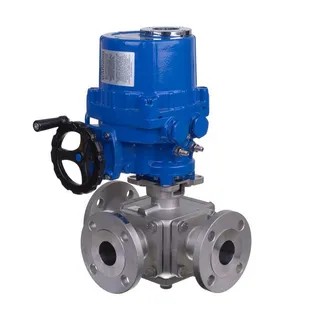Understanding 3-Way Stainless Steel Electric Ball Valves: Design, Applications, and Benefits
Introduction
In industrial and commercial systems, controlling the flow of liquids and gases is essential for efficient and reliable operations. One of the most effective solutions for precise flow management is the 3-way stainless steel electric ball valve. Known for its durability, versatility, and automation capabilities, this valve plays a critical role in regulating media flow through piping networks. This article explores the design, working principle, applications, and advantages of 3-way electric ball valves, particularly in demanding environments that require high performance and reliability.
What is a 3-Way Electric Ball Valve?
A 3-way electric ball valve, sometimes called a 3-way motorized ball valve, controls the flow direction of liquids or gases by using a rotating ball with a bore inside the valve body. Powered by an electric actuator, this ball rotates a quarter turn to open, close, or redirect flow through the valve’s three ports.
Unlike traditional 2-way ball valves, the 3-way valve’s three-port design enhances its functionality by enabling mixing, diverting, or distributing media between multiple flow paths. This makes it a flexible choice in complex piping systems.
Design Types: L-Port vs. T-Port
T-Port Valve
The T-port valve features a ball bore shaped like the letter “T.” This configuration allows it to mix two fluid streams into one or divide a single inlet into two outlets. It is ideal for applications requiring combining or distributing fluids.
Example: In a mixing process, fluids from two separate sources can be combined into one output line via a T-port valve.
L-Port Valve
The L-port valve has a 90-degree bore forming an “L” shape. It directs flow between two ports, allowing media to flow from one inlet to either of two outlets, but not both simultaneously. This is commonly used to switch flow between two sources.
Example: An L-port valve can alternate flow between two tanks, ensuring only one tank feeds the downstream system at a time, preventing cross-contamination.
Note: Typically, the pressure inlet is at the center port to prevent leakage, but exact port arrangements depend on manufacturer specifications.
Key Components of a 3-Way Stainless Steel Electric Ball Valve
Electric Actuator
The electric actuator, often a servo motor, drives the quarter-turn rotation of the valve’s stem and ball. Powered electrically, it allows precise positioning and remote operation, facilitating integration into automated control systems. Many actuators also provide feedback signals and advanced control functions.
Ball Valve Body
The valve body contains the rotating ball with the bore. Typically constructed from stainless steel for robustness and corrosion resistance, the valve body withstands high pressures and temperatures common in industrial environments.
Why Stainless Steel?
Stainless steel is the material of choice for 3-way electric ball valves due to its superior performance characteristics:
Types of Stainless Steel
- 304 Stainless Steel: Commonly used but less resistant to harsh chemicals like chlorides.
- 316 Stainless Steel: Offers enhanced corrosion resistance, especially against chlorides, making it preferred in aggressive environments such as chemical processing or pharmaceuticals.
Benefits
- Corrosion Resistance: Critical for longevity in corrosive or aggressive media.
- Durability: Strong against high pressure and mechanical stress.
- Temperature Resistance: Performs well across a broad temperature range.
In some less demanding applications, alternatives like PVC may be used, but stainless steel remains preferred for its strength and reliability.
Applications of 3-Way Stainless Steel Electric Ball Valves
These valves are widely used across industries due to their adaptability and robustness:
- Chemical & Petrochemical: For mixing, diverting, or distributing corrosive fluids.
- Water Treatment: Managing flows in potable water and wastewater processes.
- Oil & Gas: Handling high-pressure oil, gas, and fluid control in pipelines and refineries.
- Food & Beverage: Ensuring hygienic flow control with easy-to-clean stainless steel components.
- HVAC Systems: Regulating air and coolant flow for heating and cooling efficiency.
- Pharmaceuticals: Precise control of fluids in manufacturing where cleanliness is paramount.
Advantages of 3-Way Stainless Steel Electric Ball Valves
- Automation Ready
- Electric actuators enable seamless integration into control systems, facilitating remote operation and automated processes.
- Reliability and Durability
- Stainless steel construction ensures longevity and consistent performance in harsh environments, reducing maintenance and downtime.
- High Pressure and Temperature Handling
- Suitable for demanding applications requiring robust valve performance under extreme conditions.
- Versatile Flow Control
- The ability to mix, divert, or distribute flow increases system flexibility and efficiency.
Conclusion
3-way stainless steel electric ball valves combine strength, versatility, and precision to meet the demands of modern industrial and commercial systems. Their corrosion resistance, automation compatibility, and robust design make them an excellent choice for applications requiring reliable flow control of liquids and gases under high pressure and temperature.
By understanding the valve’s design options—such as the L-port and T-port configurations—and selecting appropriate materials, engineers can optimize process efficiency, safety, and longevity. The integration of electric actuators further enhances operational control, making these valves indispensable for industries from chemical processing to water treatment and beyond.





Comments